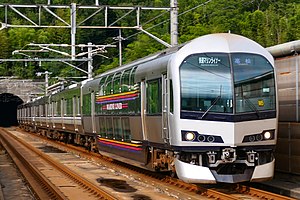Marine Liner
This articleneeds additional citations forverification.(June 2014) |
 TheMarine Liner41 service to Takamatsu passing Kimi Station, led by a JR Shikoku 5000 series EMU | |
| Overview | |
|---|---|
| Service type | Rapid |
| First service | April 1988 |
| Current operator(s) | JR West,JR Shikoku |
| Route | |
| Line(s) used | Seto-Ohashi Line |
| Technical | |
| Rolling stock | JR West223-5000 seriesand JR Shikoku5000 seriesEMUs |
| Operating speed | 130 km/h (81 mph) |
TheMarine Liner(マリンライナー,Marin Rainā)is a rapid train service inJapanoperated byWest Japan Railway Company(JR West) andShikoku Railway Company(JR Shikoku) since April 1988. TheMarine LinerlinksOkayama,the capital city ofOkayama Prefectureand a major station on theSanyō Shinkansen,withTakamatsu,the capital city ofKagawa Prefectureon the island ofShikoku,via theGreat Seto Bridge.Operating at a top speed of 130 km/h (81 mph), the journey takes approximately 52–63 minutes.
Overview[edit]
Since 1 October 2003, theMarine Linerhas been operated by JR West223-5000 seriesEMU trainsets. The first car on most Takamatsu-bound trains is a JR Shikoku5000 seriesbi-level cab car with reserved seating. Previously,213 seriesEMUs were used.
From Okayama to Takamatsu, allMarine Linertrains stop atChayamachi,KojimaandSakaide.Most trains also stop at eitherSenooorHayashima,or both. Some early morning and late evening trains make additional stops at intermittent stations on theSeto-OhashiandYosanlines.
As it is classified as a "Rapid"(Khoái tốc,kaisoku)service, only a standard fare is charged for using theMarine Liner.It currently takes about one hour to cover the entire journey. A passenger may upgrade to reserved seating, in both standard seats or Green Car seats for an additional fee.
A crew change for the train driver and conductor occurs at Kojima, the boundary station between the two operating railways.
Route[edit]

TheMarine Linerruns over two sections known collectively as theSeto-Ohashi Line.The Okayama-Kojima section is operated by JR West1,and the Kojima-Takamatsu section is operated by JR Shikoku2.
1Portions run over the JRUno Line
2Portions run over the JRYosan Line
Stations[edit]
- Key (as of December 2006)
| ■ | All trains stop |
| ▲ | Most trains stop |
| ♦ | Few trains stop |
| —- | Pass/No trains stop |
| Station | Service | |
|---|---|---|
| Okayama | Cương sơn | ■ |
| Ōmoto | Đại nguyên | ♦ |
| Bizen-Nishiichi | Bị tiền tây thị | ♦ |
| Senoo | Muội vĩ | ▲ |
| Bitchū-Mishima | Bị trung ki đảo | —- |
| Hayashima | Tảo đảo | ▲ |
| Kuguhara | Cửu 々 nguyên | —- |
| Chayamachi | Trà ốc đinh | ■ |
| Uematsu | Thực tùng | ♦ |
| Kimi | Mộc kiến | ♦ |
| Kaminochō | Thượng の đinh | ♦ |
| Kojima | Nhi đảo | ■ |
| Great Seto Bridge | ||
| Sakaide | Bản xuất | ■ |
| Yasoba | Bát thập tràng | —- |
| Kamogawa | Áp xuyên | ♦ |
| Sanuki-Fuchū | Tán kỳ phủ trung | —- |
| Kokubu | Quốc phân | ♦ |
| Hashioka | Đoan cương | ♦ |
| Kinashi | Quỷ vô | ♦ |
| Kōzai | Hương tây | —- |
| Takamatsu | Cao tùng | ■ |
Formations[edit]
Services are formed as 2-, 3-, 5-, or 7-car formations as shown below with car 1 at the Takamatsu end. All cars are no smoking. Most of the trains use 5-car formations.
- Green: Green class (first class)
- White: Standard class
- G (green class), R (standard class): Reserved seats
- NR (standard class only): Non-reserved seats
| 1 | 2 |
| 223-5000 series | |
| NR | NR |
| 1 | 2 | 3 |
| 5000 series | ||
| G | NR | NR |
| R | ||
| 1 | 2 | 3 | 4 | 5 |
| 5000 series | 223-5000 series | |||
| G | NR | NR | NR | NR |
| R | ||||
| 1 | 2 | 3 | 4 | 5 | 6 | 7 |
| 5000 series | 223-5000 series | 223-5000 series | ||||
| G | NR | NR | NR | NR | NR | NR |
| R | ||||||
History[edit]
TheMarine Linerservice was introduced in April 1988, using 3-car213 seriesEMUs formed as three-car, six-car, or nine-car formations.[1]
References[edit]
- ^Liệt xa danh giam 1995[Train Name Directory 1995]. Japan: Railway Journal. August 1995. p. 78.
External links[edit]
- JR WestMarine Linerinformation(in Japanese)
- JR ShikokuMarine Linerinformation(in Japanese)
